
21 minute read
RING UP THE CURTAIN
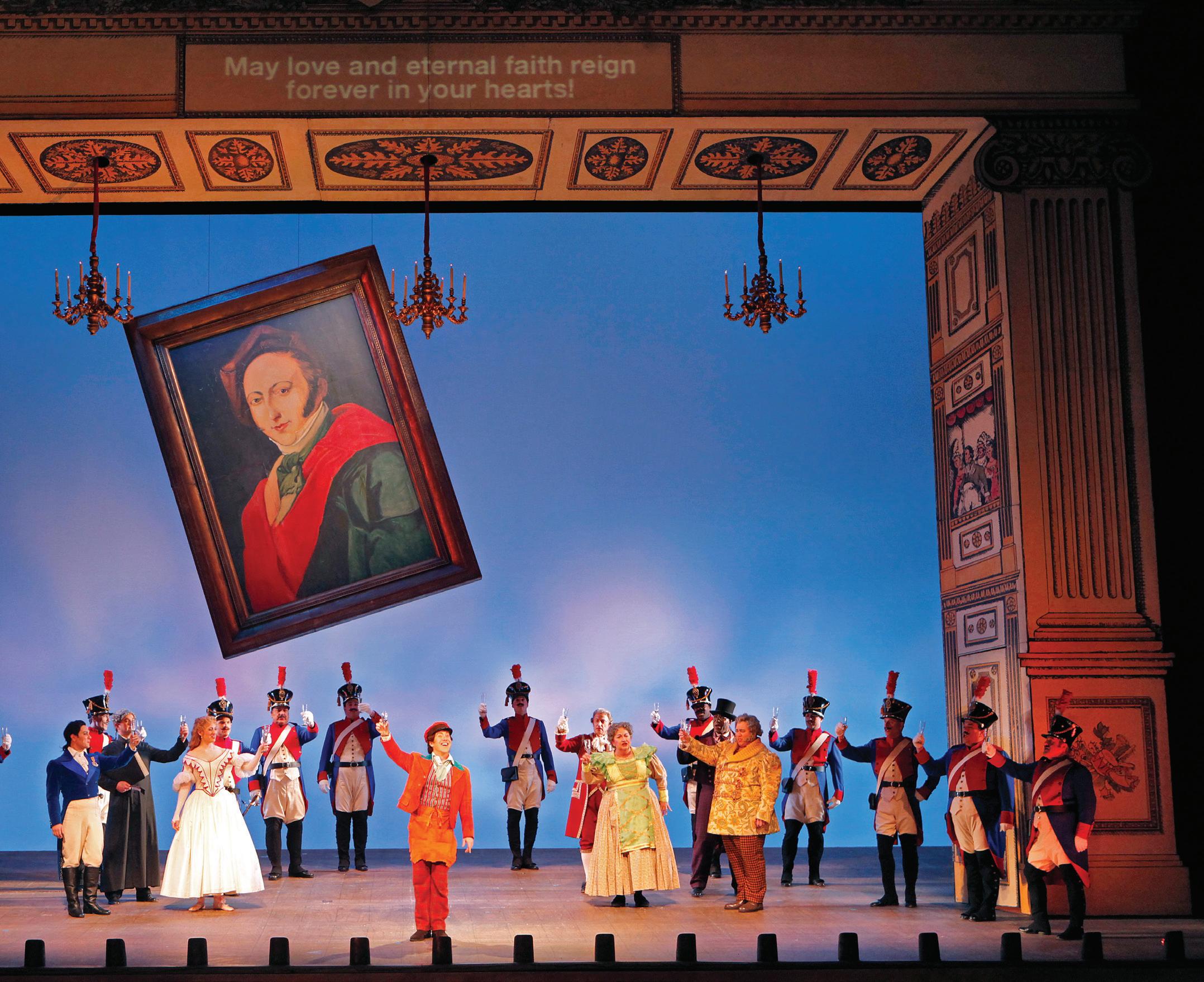
THE PERFORMING ARTS COME BACK TO THE STAGE FOR LIVE AUDIENCES.
BY LEE CULLUM
And there was only one way out—the artist had to fling himself into the abyss in the belief that when he reached the bottom, he would not be dead, but would be newly born. –El Lissitzky
And so the abyss is where they are now, those actors, musicians, dancers, and singers, flinging themselves onto the stage, hoping for an audience, hoping to keep their health, hoping to make a living, hoping to survive as artists. The times are surreal, but Suzanne Césaire, anti-colonial French activist, and writer from Martinique, said in 1943, “Surrealism is the tightrope of our hope.” Mezzo soprano Joyce DiDonato, who sang spectacularly in a recital for The Dallas Opera earlier this year, put it like this: “We are going to have to create our way out of this pandemic.” As Hemingway put it, “Wouldn’t it be pretty to think so?”


The Dallas Opera
“Music takes the sting out of the day.” That’s how Ian Derrer responds to my rant about the FDA; the CDC; the Texas Legislature, notorious no matter who’s in charge; and Bosch for stopping at season seven on Netflix. But Derrer is right, and as general director and CEO of The Dallas Opera, he’s certainly doing his part to give us happy alternatives for our evenings. Opera’s Greatest Hits was a big success, the Winspear no longer lonely but filled only to 50 percent, with a masked audience. A lighter-hearted version was offered free in Strauss Square.
Next came the Hart Institute for Women Conductors, not only still alive but actually live again, with a concert featuring all the aspiring, inspiring maestros at the Winspear. One of the past participants, Lina Gonzalez-Granados, has turned out so impressively she is leading The Dallas Opera Orchestra in The Barber of Seville in March. Also, all the stage directors this season are women.
A past winner of TDO’s vocal competition, also reprised in the fall, Latonia Moore is a sensation in Terence Blanchard’s Fire Shut Up in My Bones, which opened the Met in September. Moore will launch The Dallas Opera’s long-awaited season as well in February, in Madame Butterfly—in the title role, of course.
The Dallas Opera has scored another casting coup in Will Liverman, the principal star of Fire Shut Up in My Bones. He’ll appear in March in Flight, an English-language work by Jonathan Dove. That production will also bring to Dallas the formidable soprano Karita Mattila, who did the most riveting Salome at the Met anybody has or will ever see. After strenuous work at the gym, she performed the Dance of the Seven Veils for Herod, stripping finally, for an instant, to nothing but her well-toned self. She will not do that in Dallas, but no doubt could if called upon.
Dallas Symphony Orchestra
As president and CEO of the Dallas Symphony, Kim Noltemy has turned survival into an art form. Deep into the pandemic, with no vaccines and no hope, she presented her musicians on the stage of the Meyerson. There were only 40 at a time, half the full force, carefully spaced for maximum protection. Tested every day they played, these masters of strings, timpani, woodwinds, and brass were under contract, being paid, after all. So why not invite a limited audience, mainly subscribers, into the hall to see them? That number has grown along with public confidence and now has reached about 50 percent of capacity. There it will stay until further notice from the CDC.
After a daring year with Fabio Luisi conducting the DSO and the Metropolitan Opera Orchestra in Mahler’s First Symphony; a dynamite gala performance by violinist Anne-Sophie Mutter (probably the best in the world; her former husband Andre Previn used to say so) playing John Williams’ Second Violin Concerto, written for her; the Mozart Requiem; and soprano Renée Fleming singing Letters from Georgia, in O’Keeffe’s own words, the DSO will turn to Tchaikovsky’s Eugene Onegin as an opera in concert in April, and in May to Beethoven’s Ninth with Angel Blue, another star of Fire Shut Up in My Bones, as well as bass-baritone Soloman Howard, who made news during the bows after Tosca at the San Francisco Opera by proposing to soprano Ailyn Pérez, frequent luminary at TDO. She said yes.
Never one to miss an opportunity, Noltemy has moved decisively into digital, installing below stage a control room equipped to video concerts for streaming and broadcast. Indeed, Bloomberg will air the Mozart Requiem starting Dec. 4 and a holiday show with CEOs on the podium starting Dec. 18.


Dallas Theater Center
Kevin Moriarty, artistic director of the Dallas Theatre Center, can make you feel you are the one person he’s been yearning to talk to. “Great to hear from you,” he responds quickly to my entreaty for an interview. “I’m emailing from an airplane flying back to Dallas from Chicago, where last night we celebrated opening night of DTC’s production American Mariachi at the Goodman Theatre. Today when I land, I go into rehearsals for The Supreme Leader, and in the evenings we are currently running both Tiny Beautiful Things and Cake Ladies at the Wyly. So after 17 months of no indoor theater, we’re now fully back!”
Jonathan Norton, the gifted writer of Cake Ladies and Penny Candy is now in residence, on full-time staff and paid. DTC will do one of his plays each year. Moriarty plans to put his resident company under contract and pay them a salary, then expand from eight to 11 or 12 actors—although actors are as hard to hire today as restaurant workers. He started out with smaller, intimate plays such as The Supreme Leader, about North Korea’s Kim Jong-un when he was a student prince in Switzerland, but The Sound of Music, on a grander scale, is waiting in the wings, hoping for a spring production uncurtailed by variants of COVID.
Masks are the order of the hour at both DTC theaters, the Kalita Humphreys and the Wyly, and there are special seats with social distancing for those who want them. The Goodman in Chicago requires proof of vaccination to get into the theater, but that is not possible for the DTC, which receives money from the Texas Commission on the Arts and cannot risk losing that or the liquor license held by the AT&T Performing Arts Center. Governor Abbott is adamant about this.
The last play of the season may be the most interesting of all. Alice Childress wrote Trouble in Mind in 1955 and almost became the first Black female playwright to have a work on Broadway. The producers liked the play but wanted Childress to change the ending to make it more palatable for white audiences. She said no, and Lorraine Hansberry became the first Black woman to put a play on Broadway with A Raisin in the Sun. “There’s a white director in the show who’s a ‘blowhard,’” says Moriarty, and the Black actors question his choices. “All the characters think of themselves as progressives,” Moriarty points out, “but some want to keep things the way they are. It’s funny and smart” and it’s a matter of “discovering a work that nobody has seen.”

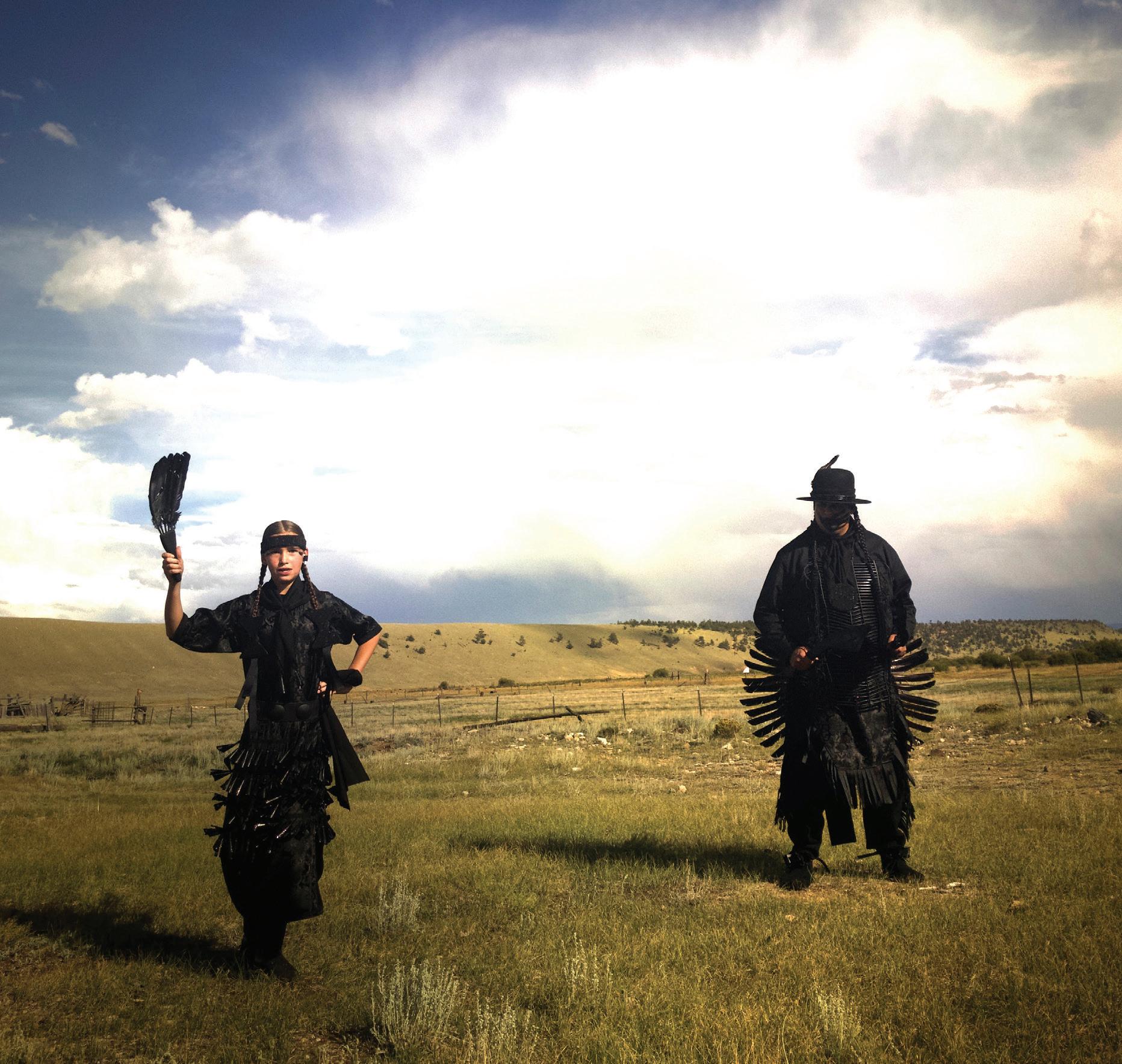
Undermain Theatre
Kevin Moriarty had to sign off from our conversation because he was headed to the Undermain to catch Stronger Than Arms, an extraordinary tour de force by Danielle Georgiou and Justin Locklear. Based on the premise that “fear is stronger than arms,” this is typical fare at the Undermain, where Bruce DuBose and his late wife, Katherine Owens, kept the torch aloft and burning for theatrical experience at its most elemental, where ancient wisdom dares to speak sense to modern sensibility.
DuBose, a brilliant actor as well as cofounder and producing artistic director of the Undermain, followed with a live production of his streaming sensation, Conor McPherson’s St. Nicholas, which was discovered by Terry Teachout of the Wall Street Journal and justifiably praised as a masterpiece of online drama. This one-man show was directed by Blake Hackler, chair of SMU’s Drama Department.
In bringing his audience to the Undermain, DuBose has had to revamp the HVAC system, installing UV light filters, to make his basement space habitable in the age of COVID. Now the audience is limited to 36 carefully distanced people. The good thing about all this, DuBose admits, is that the air conditioning is quieter.
Music performances came next and will continue into the new year. Then will arrive Whither Goest Thou, America: Festival of New American Play Readings and Lonesome Blues about “Blind Lemon” Jefferson, a Texas singer in the early 20th century, when Deep Ellum was “a crossroads for the blues,” notes DuBose. Lonesome was one of the last shows Katherine Owens directed, in the summer of 2018, off-Broadway, he recalls.
Another Owens legacy is the Undermain Fund for New Work that bears her name. The first award, a $10,000 commission, went to Lenora Champagne for Feeding on Light, a play about the French philosopher Simone Weil, whom Albert Camus called “the only great spirit of our times.” The theatre will hold a staged reading in the spring. The latest beneficiary of the fund is Gregg Deal, a Native American performance artist. His creation, The Punk Pan-Indian Romantic Comedy will close this year’s festival.


Theatre Three
It’s been “one curve ball after another,” laments Jeffrey Schmidt, artistic director of Theatre Three. COVID has kept him out his theatre in the Quadrangle, but so has massive construction. The center is being overhauled by new owners. Schmidt’s space will be pretty much the same, though the lobby will be larger, and he’ll have more visibility from the street—a fortunate change, since Theatre Three can be hard to find.
Theatre Three was the first professional company to come back live after the Ides of March minus two, 2020. It was The Music Man that brought this troupe out of the shadows and into the streets in June, performing wherever they could find an outdoor venue, from Coppell to Cedar Springs to the Texas Discovery Gardens at Fair Park.
For all the joy they generated, “this way of working [where everybody does three or four jobs at once] is not sustainable,” Schmidt acknowledges, but “I don’t know what the alternative is.” Nonetheless he’s pressing on. Theatre Three did Little Shop of Horrors in the Samuell-Grand Amphitheatre in October, presented in repertory with the Shakespeare Dallas production of Romeo and Juliet, and now plans to open two new plays in 2022, culminating in Edward Albee’s Who’s Afraid of Virginia Woolf?
Schmidt is the only one I spoke to who admits he would love to require proof of vaccination, especially if the union would decree it and he could blame it on them. He was joking, sort of, but even without help from the union, he hasn’t given up hope on this front. He also feels “we have exhausted digital…and people’s goodwill to donate” to quasi-occasions online. “No more live events,” he declares, “no more live theatre.”
When he spoke of curve balls, Schmidt was more serious than at first I realized. He tells me he lost his father to COVID in December, followed by his grandfather three weeks later. So now his mother and grandmother are alone on a farm in East Texas where he grew up, dreaming, perhaps, of theatre, but not the desperate drama of the past two years.
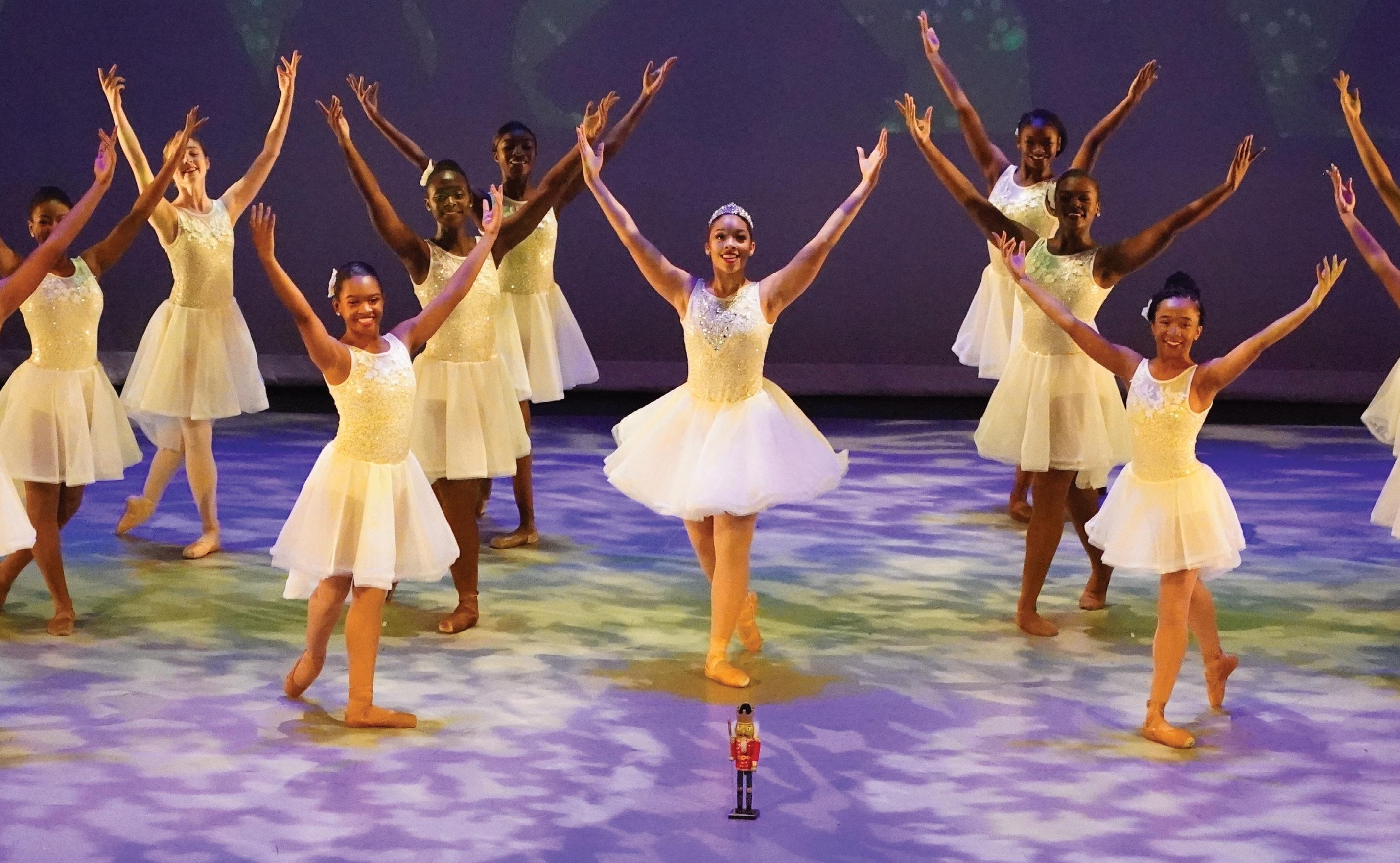
Dallas Black Dance Theatre
The last time I spoke with Melissa Young, artistic director of the Dallas Black Dance Theatre, we were like Cole Porter sang, “Down in the depths, on the ninetieth floor” of COVID, and she was working hard to hold tight to her nerve, touting real success in the virtual afterlife, and looking ahead to more. Now, however, she is herself again, ebullient and bursting with projects and plans. “Everything is possible with a good plan,” she insists, and she has plenty of them.
Dallas Black Dance Theatre returned triumphantly to the Wyly in November with Directors Choice. Designed to celebrate the company’s 45th anniversary, the program showcased favorite dances that audiences adore plus some that current dancers wanted to perform but never had. It’s all part of Young’s effort to “begin again, shake things up and reinvigorate minds, bodies, and spirits.” She won’t “close the virtual door”—they’ve done too well with it for that— but will livestream one evening of each show at the Wyly, keeping it available for two days afterwards. She’ll continue Black on Black in DBDT’s studio in December and treat her audience to newly choreographed works by members of both companies using the music of “Black legends.” Who? I ask. “I don’t want to give that away,” she replies but promises it will be “like a jukebox.”
For the holidays the Dallas Black Dance Academy is presenting Espresso Nutcracker at the Majestic Theatre—“shades of brown,” as Young describes it, featuring not only Tchaikovsky but also Duke Ellington. Last year, this show attracted the most viewers of all their 21 events on offer virtually.
Working from a wall in her office papered with gigantic Postits—she calls it her “vision board”— Young looks ahead to her Cultural Awareness program in February, when jazz guitarist Toni Kitanovski and his band will arrive from North Macedonia to continue a collaboration with DBDT begun before COVID. It’s all the magic of movement at Dallas Black Dance Theatre, where truth is a consequence of fantastic artistry. After all, says Young, “Art is the very thing that has gotten us through this.”

Bruce Wood Dance
“On or about December 1910 human character changed,” wrote Virginia Woolf, and this brought about a shift in human relations. “And when human relations change,” she continued, “ there is at the same time a change in religion, conduct, politics and literature.” She might have added art. It is that shifting ground that Joy Bollinger, artistic director of Bruce Wood Dance, sees in the painting Cathedral by Jackson Pollock. She has been giving a lot of thought to this work ever since the Dallas Museum of Art commissioned her to use it as the basis for a dance. It’s all part of Slip Zone: A New Look at Postwar Abstraction in the Americas and East Asia.
Painted in 1947 and given to the DMA, Cathedral, Bollinger believes, is a picture of an artist “unsettled.” “It was after World War II,” she observes. Pollock saw that “art must change to express the change young people experienced at a very young age. Art… an important way to heal from trauma.”
Bollinger is choreographing all this into dance for the DMA’s Horchow Auditorium in April with a repeat performance at the Moody in June as part of the company’s SPRING production. Invigorated by the “sedimentary layers” of postwar abstraction, Bollinger and her company will also create a full suite of dances, including duets and ensembles, inspired not just by Cathedral but by five or six other paintings in the museum’s collections.
Company executive director Gayle Halperin, who started the company with Wood just over ten years ago, launched the first Dallas Fall Arts Festival in Klyde Warren Park in October. Co-producing with the Dallas Conservatory, she gathered Bandan Kora African Drum and Dance Ensemble, Anita M. Martinez Ballet Folklorico, the Greater Dallas Youth Orchestra Jazz Combo, and B. Moore Dance among others for an afternoon of free family festivity.
This marked a moment of reemergence for Bruce Wood Dance after months of rehearsing, masked, five-hours a day, in a studio equipped with a refurbished air-conditioning system buttressed by ionizers and UV lamps. The company has created films in a new way, segmenting dances into themes, then repeating shots from different angles and editing them into videos far more sophisticated than the archival footage they had done before. Searching for places to make those films they found a park in Grand Prairie, among other spots, and an especially haunting setting on Mountain Creek Lake. There they explored in tragic movement the life of Reuben Johnson, who was lynched near that same site in 1874. Choreographer Adam McKinney, professor of dance at TCU, created a startlingly powerful dance for dancer Matthew Roberts, placing him in a field, on a tree, and, finally, in the water, disappearing beneath the waves.
By November Bruce Wood was back at the Moody, open to a full house, with masks. ReNEW, highlighting Elemental Brubeck, revives the reassuring ’50s, choreographed by Lar Lubovitch. The beat goes on at Bruce Wood. It’s as if this company never missed a beat at all.

TITAS DANCE/UNBOUND
Charles Santos, executive director of TITAS, is quick to point out that his is a presenting, not a producing, company. Hence salvation by streaming was not as available to him as it had been to others. There are too many rights involved when dealing with traveling troupes, which can be expensive and not always easy to get. So TITAS is mostly all live all the time by necessity as well as by choice.
Santos has spent the past several months rebooking dancers he had to cancel because of COVID, struggling to get visas for some of them, and hoping it will all work out. He still speaks candidly about the strain of keeping art alive in the world of COVID. Only weekly calls with other impresarios in the Dallas Arts District kept him afloat. After those sessions, now every other week, he would get in touch with smaller groups to pass along the latest angst and ways of coping.
Now Santos is back in the saddle, riding that bronco again, staging productions of Alice with MOMIX in September; Somewhere from West Side Story, abstracted into pure, plotless movement by Doug Varone and Dancers in October; and Rubberband from Montreal in November.
Coming up in the year ahead are Ballet Hispanico, celebrating its 50th anniversary in January; A.I.M. by Kyle Abraham—notable as the company of Dallas’ Catherine Kirk—in March; Compagnie Marie Chouinard dancing before a projected triptych of Hieronymus Bosch’s Garden of Earthly Delights in April—Santos warns that this garden has nudity; and BalletX of Philadelphia in June. Amid all this, in April TITAS will mark its own 40th anniversary and Santos’ 20th at Command Performance in the Winspear.
TITAS has operated in a bubble, putting touring artists up in a hotel, where they spend all their time when they’re not at the Moody or the Winspear. Full vaccinations are required by contract, and breakfast, lunch, and dinner are delivered to the dancers in individually wrapped packages. There is “no ambiguity,” Santos stresses, adding that it will take “time and education” to get the audience to return. He would love to have 100 percent capacity in the hall, but “the general public is not here yet.” To nudge them along he’s inviting a few people, maybe eight, to dress rehearsals.
TITAS, he knows, is lucky to still to be standing. “Some groups around the country are “on the brink,” he points out. “Dancers have left the field.” One is in the jewelry business, another is a fireman, another a police officer. Some have gone back to school or into real estate or teaching. And Santos, while warding off calamity, went into surgery for two ruptured discs, possibly caused by an old dance injury. When we speak, he is back in the office two to three hours a day and just beginning to drive again. Even so, he’s convinced that this is “an extraordinary time for problem solvers. We can do this, figure it out.”

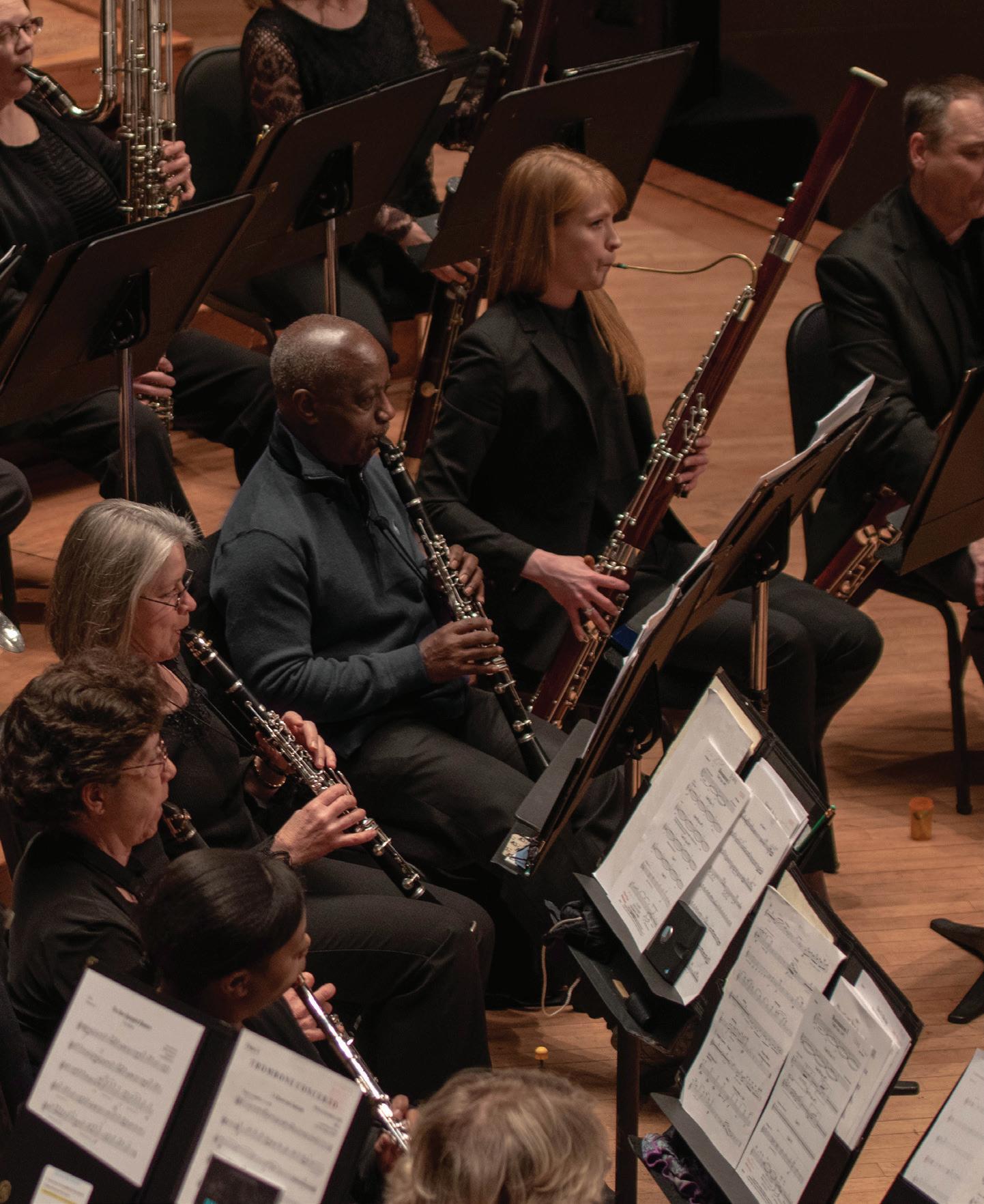
Dallas Winds
Kim Campbell is a bass trombonist; an ordained minister (state of California) who has performed five weddings in the past five years; and the founder and executive director of Dallas Winds, one of the few bands of its kind in the country. These 50 brass, wind, and percussion players are freelance musicians who also work as software programmers, financial planners, accountants, and in other professions when they’re not performing at the Meyerson. Some of them started playing in school then let it go. Campbell has given them a chance to “pick it up again.” Luckily for them, they live in a part of the country that has 22 community bands. Houston has eight. There is “huge talent” here, says Campbell.
Right now, Campbell is preparing for Christmas at the Meyerson in December, with more John Williams in February; The Planets, op. 32 by Gustav Holst in March, with projections from the Hubble Space Telescope; Canadian Brass teaming up with the Dallas Winds in April; and A Star-Spangled Fourth of July to wrap up the season.
Band Camp is a major summer project for Dallas Winds. Working with DISD, they teach music to 600 middle and high school students, at $25 each for a week of instruction at Booker T. Washington School for the Performing and Visual Arts. After that it’s off to the Meyerson, where they play in a concert. Making videos became the order of the hour at Dallas Winds, as it was everywhere during the COVID lockdown. So young musicians at DISD were not abandoned; they had a musical life online.
Kim Campbell hopes to retire to Taos in another year. Then he’ll “return to the trombone” he expects, and “do a few weddings.” It’s impossible to overstate what he and all these impresarios mean to all our lives. They are subsidizing the culture, saving civilization, and helping the arts redeem the alienated life we for too long have been living.
From left: Dallas Winds Come Sunday; Dallas Winds founder Kim Campbell. Photography courtesy of Dallas Winds; Fort Worth Symphony Orchestra’s music director Robert Spano onducts at the Will Rogers Auditorium. Photograph by Karen Almond; FWSO Pulling Back the Curtain: Sibelius, Dvořák, and Brian Raphael Nabors. Photograph by Karen Almond.

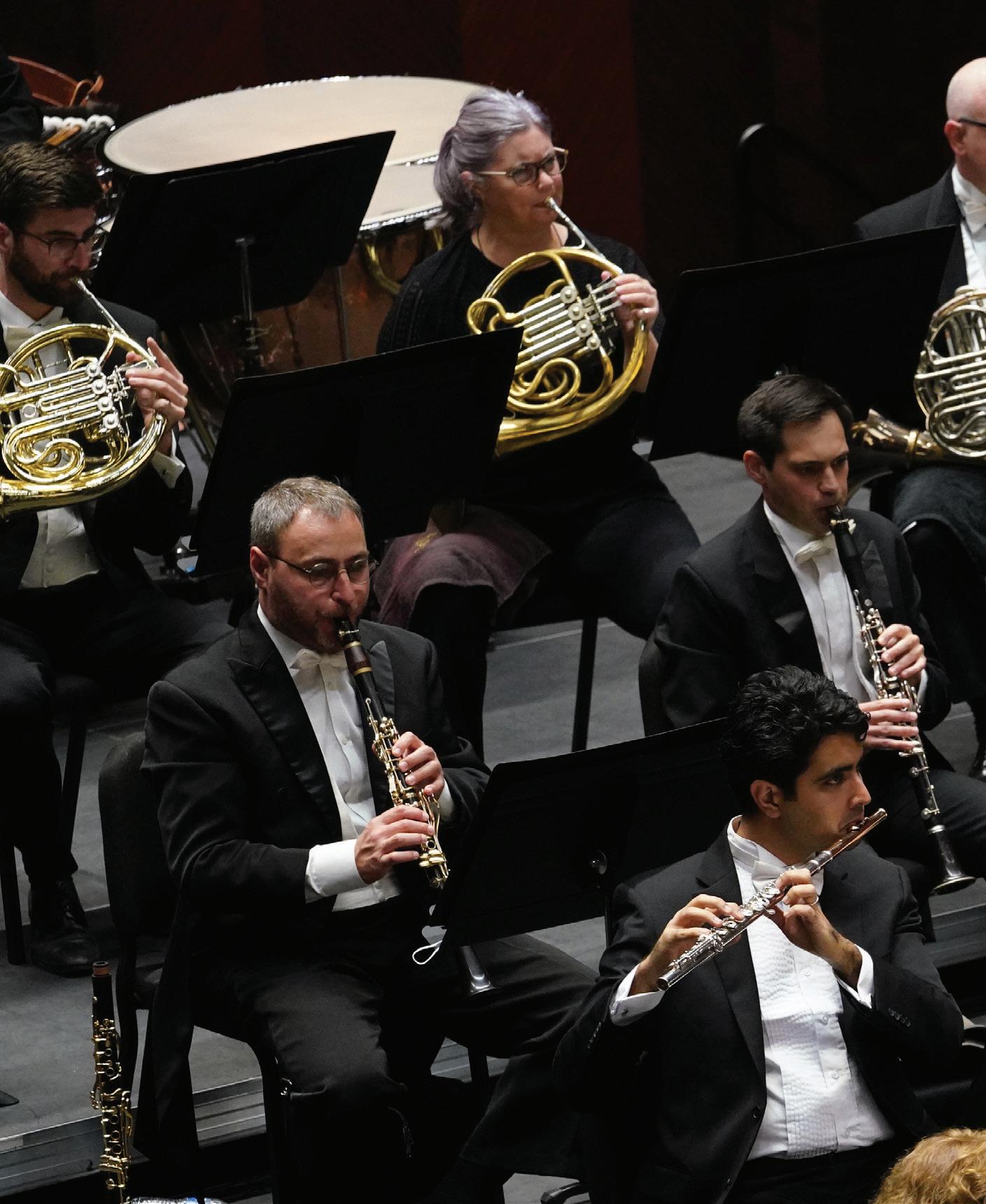
Fort Worth Symphony Orchestra
In Fort Worth, Keith Cerny, president and CEO of the Fort Worth Symphony Orchestra, collected three seven-figure gifts during the height of the pandemic, and one of them, from board chair Mercedes Bass, was, “transformative,” he says. It meant there were no furloughs, no layoffs, and now, with the orchestra over 90 percent vaccinated, they are back in Bass Hall, at full capacity but with the audience in masks. “We have gone from zero to 100 mph,” he reports, and they ended their fiscal year with what looks like a $350,000 surplus. “Stay live.” That’s the motto at the Fort Worth Symphony, and they have done just that, starting with a sold-out show of video-game music in August (these scores have been a big hit in London too, and at the Tokyo Olympics) and continuing with film soundtracks by John Williams (who wrote the electrifying violin concerto that Anne-Sophie Mutter played in Dallas). Now they’re looking ahead to three concerts led by new conductor Robert Spano, soon to arrive for his first full season (2022-23) from Atlanta, where he built an international reputation for himself and his orchestra.
The Hart Institute is represented yet again by Lidiya Yankovskaya, who’ll lead the Fort Worth Symphony in a March celebration of George Gershwin and William Dawson. She also presided over a tribute to Ruth Bader Ginsburg at the DSO. Dallas and Fort Worth are thinking along similar lines for the holidays: the music of the ’40s and ’50s, when life may not have been easier but at least there was clarity, and the “Greatest Generation” had the situation in hand. That seems to be the idea behind A Very Swingin’ Basie Christmas at the Meyerson and Swing Is the Thing to ring in a welcome new year at Bass Hall. Who isn’t ready for Blue Skies?
Cerny is resuming his chamber music series at the Kimbell Art Museum along with his “Meet the Composer” sessions, also at the Kimbell, where he asks what the composer is trying to accomplish. Was it successful? Certainly, Cerny has been successful in keeping the Fort Worth Symphony alive during a siege that only someone with a “war games mentality” as he puts it, could survive. Part of the answer, he notes, is keeping everybody informed about everything. This helps avoid the kind of upheaval suffered by the San Antonio Symphony, where musicians went on strike, forcing concerts to be postponed. Quite true. As 17th-century British philosopher Francis Bacon warned, “Nothing makes a man suspect much, more than to know little.” P










